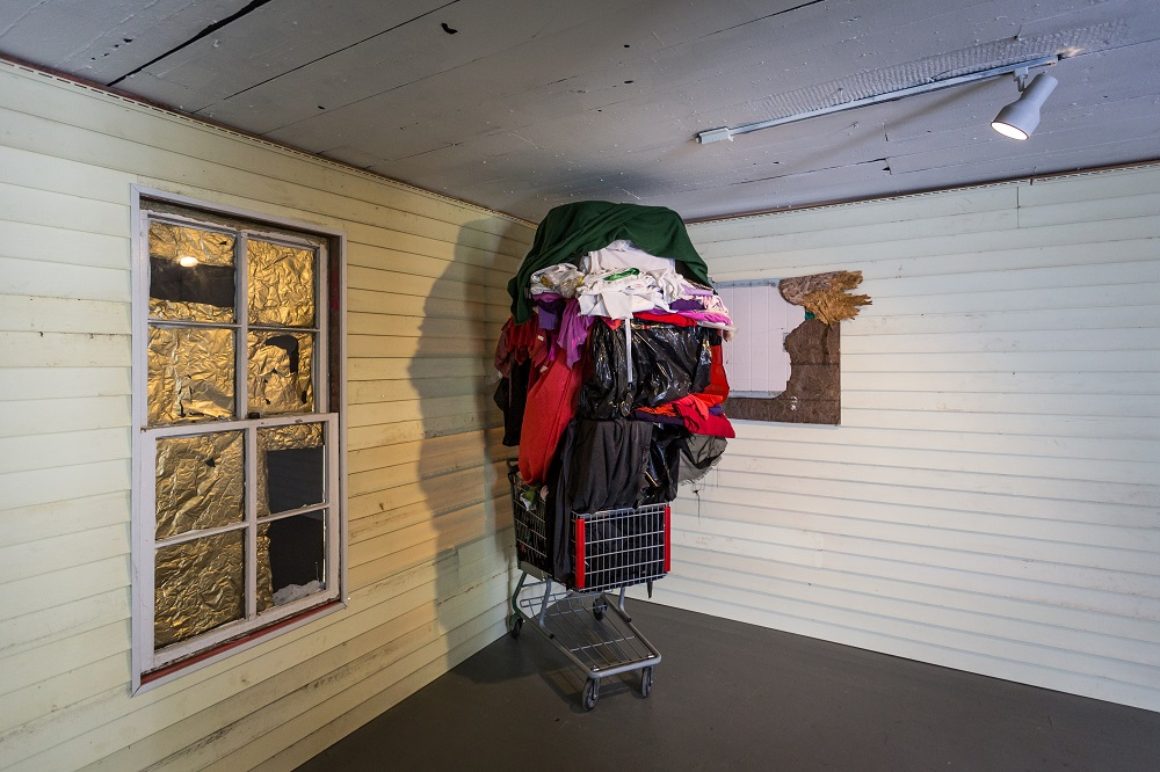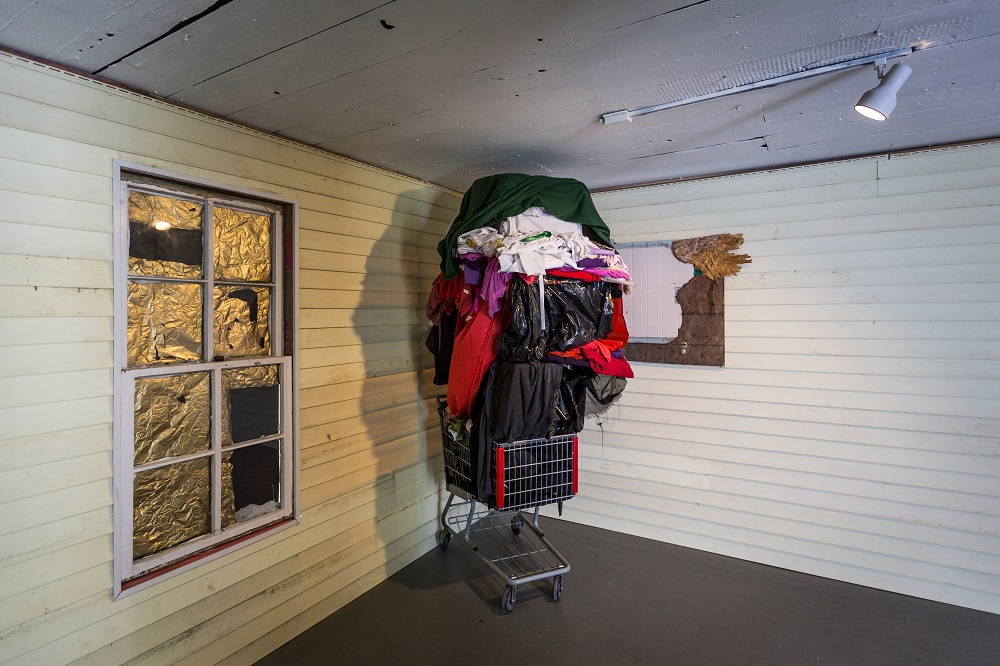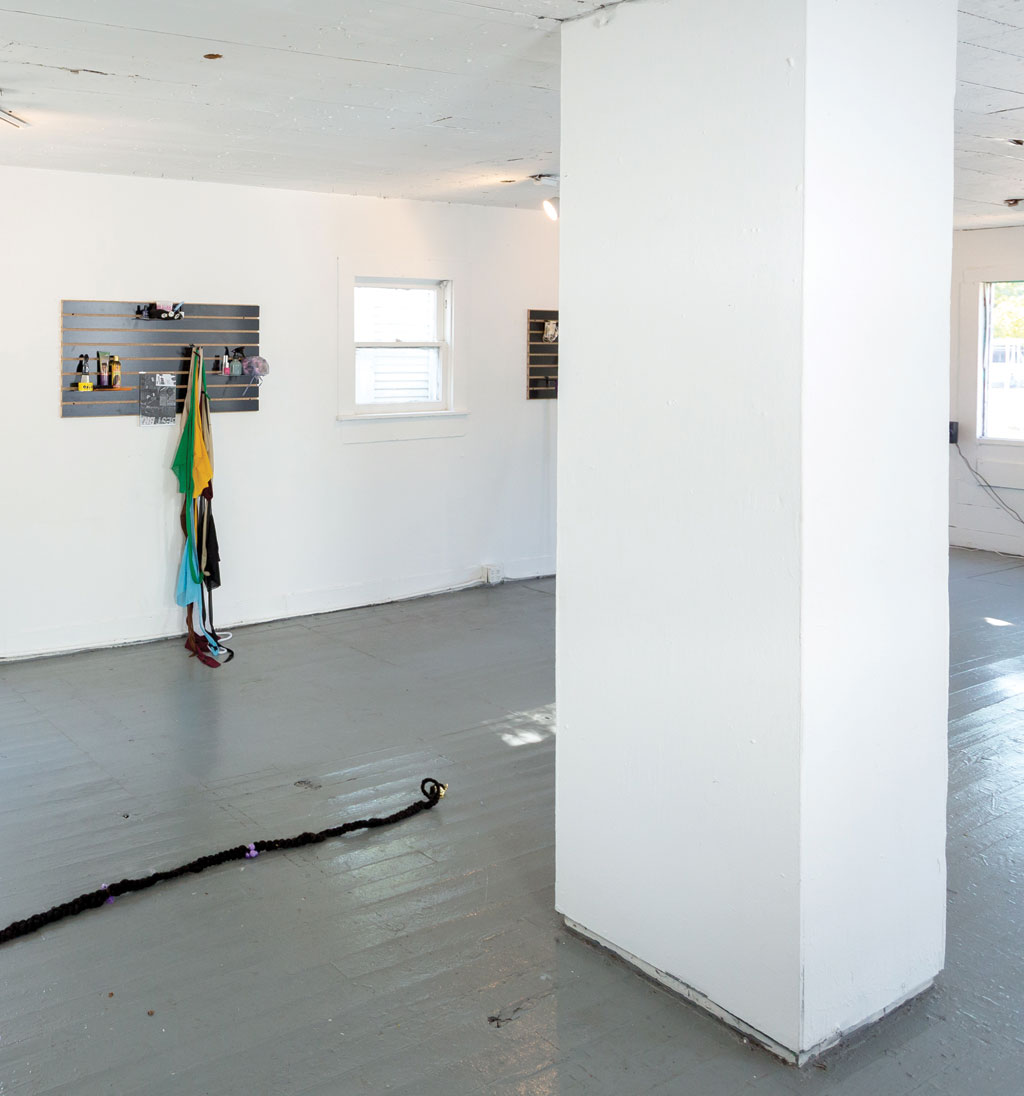by Victoria Laxalt
Photos by Alex Barber
Website, blog, or other relevant links?
My website is www.nathanieldonnett.com and I’m the weblog founder along with contributing founders of www.notthatbutthis.com
Please describe your installation at PRH for those who aren’t able to view it firsthand.
My piece at PRH is an installation environment consisting of light, objects, found materials, and photography. It is set up to engage the viewer regarding things like perception, psychology, value, the everyday, dark imaginarence, space, class, cultural architecture, belonging, and to question the legitimacy of contemporary art and art history. The outside of the row house looks like a normal row house yet upon entering it is a house that has been turned inside out or flipped, if you will. There are vinyl house panels, boarded up windows, and a part of the wall that is made of brick. The brick wall has an opening that presents a backlit photograph of a hallway to yet another row house. Bricks are in front of the photograph as if someone has knocked them out attempting to leave the hallway of the row house or pulled them out trying to peek into or enter the photographic hallway. To some it may act as a type of portal. Either way it is a poetic notion that suggests one may or can never find home although one is always home in some way. Home is not static; it is fluid and forever changing. In fact traces of home are left as echoes of our being through an extension of cause and effect.
There is also a metal shopping cart that you’d find at a grocery store like Kroger or Fiesta filled with objects, clothing, fabric, cups, etc. It resembles the types of carts some homeless people use to hold their personal property they acquire moving through space usually an unwelcoming space. I had many questions as I usually do and a few ideas about how people occupy space and how it is created or what adjustments are made to acquire it. Space not only meaning geographical but also psychological and emotional. The citizens of New Orleans, for example, were displaced during Hurricane Katrina and sought out spaces of normalcy. There is the psychological impact of space where blacks in the south migrated to the north for more opportunities during and post slavery. There is the loneliness one experiences from being poor and continually forced to move because of gentrification or class prejudices. All of these disparate interests and ideas created a conceptual opening for me to think about and present to the viewer.
I was thinking about how people, objects, culture, and even class are perceived and valued. There was a discussion between Sally Frater (the curator of the round) and I about relationships between black people in the United States and the African diaspora. I thought about the interesting relationship between African immigrants, particular Nigerians and Black Americans. This relationship had me thinking about the differences and similarities between the two and how they are perceived and how they perceive each other. This component of the work left me vulnerable and stranded from not knowing. (Which for me is a good thing). So for this reason I purposely interviewed two women elders, a Nigerian and a Black American. I wanted their stories to create a dialectical crossing (which I used in a performance) and as a reference I could draw from and subtly submit to the installation. There is also the site specific(ness) of it as PRH is a space that helps mothers.
As one of three Houstonian artists in this Round, how do you view the role of your work in the context of this international exhibition? And how is it perhaps uniquely Houstonian?
I don’ t know how to view it other than I’m an artist but more so I’m a human who makes art or something near art or possibly outside of art. We all are human. I think that is part of the idea of the show. That is to place humanity out there in some form, object, or idea. To signify how we operate as it relates to the human experience. I can say that the show is a self-portrait of sorts of the curator’s experiences. This point becomes twofold which is that our personal experience isn’t the only experience that exists (many people related to Sally’s perspective through their own lens) and we as people create and break down boundaries continually and to find the medium between the two enables us to become self-aware and considerate of other people’s struggle and triumphs. It is important to value all stories and people as individuals and recognize we all have stories to tell and possibly share collectively.
My work is uniquely Houstonian because I’m the source as much as the source is the source of Houston. The materials were found in Houston and all of the remnants of its history lie amongst itself. On another note Houston has lots of space and yet can feel crowded. It has the cultural history of 3rd, 4th, 5th, wards that display the African American’s imagination, fight for freedom and “kiss my ass” DIY attitude. This social historical reality of the city is embedded in all of my work because of the lived experience and my interest in parsing out the type of tradition and culture I find important and ancestral. What’s most important is I will do the work I want to do, the way I want to do it but I remain humble and open enough for constructive suggestions and advice. So it’s always moving. That’s what makes it uniquely Houston (for me).
I’m sure I’m missing something and will only remember after thinking about it more in a few days from now. Is memory lapsing uniquely Houston too? If so then that’s it!
Please explain your “dark imaginarence” concept.
Well, to begin the explanation is also in the experience, which is where the theory also rests. It is in its beginning stages as it relates to me writing it and articulating it. It is part manifesto, part statement, all idea, all action, and all rhythmic, and non-what so ever at all linear. It is partially based off “my” experiences, African American music, and social political concerns that is tied to the everyday, aesthetics, form, and concepts that are informed by African American traditions and cultures in the United States. It is an attempt to reclaim what art means to us or to me sans the erasure of black people in the west art canon. So I’m thinking about how to look at these things in terms of a cultural genealogy and refocusing a way to work that material, material as idea, form, and other things that happen along the way into the cultural practice. This installation is the perfect example of dark imaginarence.
Was the conception of your piece at all influenced by the physical and/or cultural context of the shotgun house?
It was in terms of how to mirror a specific architecture and how these houses functioned as home and canvas for personal expression that gave indication of the individual character of those who occupied it.
What do you want people to know about your work?
(Laughing) I want them to know as much as they can and yet not too much. I don’t always know what’s happening with my work until it’s done and I’m working on something else. My work is intuitive and planned. The thing is my work evolves and shifts. It is not just political or activist. It is not just white cube or social engagement. It is not always serious or humorous. What I’m working towards is the humanity and spirituality in it that is complex, simple, and meaningful and “oh whatever let’s try that!” And I know that there is no end in sight and both sides of the roads wobble. There is a framework that’s sturdy but what’s on the top is in constant motion, risk, and improvised mode. I know that everyone will not like it, get it, or think its worth anything. That’s cool too and I hope they understand I make this work for me first with the consideration that people may experience it on some level in the future. I’m truly seeking to understand things about this world and myself through my work with an attempt to bring some attention to social conditions sometimes poetically and sometimes in your face.
What’s next for you?
A group exhibition in the summer, a residency next year, and I think two solo shows next year. Who knows? Things happen, things don’t happen. The most important thing for me next is to keep creating, imagining, experiencing, thinking, remain free and thoughtful of folks, live life, love family and friends, and make a few enemies along the way just to keep perspectives in check.






